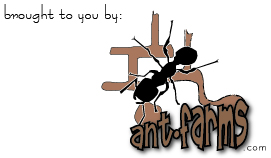Where to Get Ants to Put in an Ant Farm
The most obvious source of ants is the great outdoors. Ants live in most climates in almost all parts of the world with the exception of the extreme Northern and Southern Polar Regions. They are generally found in backyards, parks, deserts and mountains. Busy cities do not discourage ants as local ants are accustomed to the climate in the area.
Catching ants can be done by using bait over a few days. Sugar water in a small bottle in a large jar is sufficient to attract most ants. Ants can be collected periodically to be placed in the terrarium.
Another way to catch ants is to dig up a colony and sort the ants, pupae, larvae and eggs manually from the site. However, this can prove very difficult in the case of Wood Ants since extracting them from the wood nest is a very tedious task. A procedure that can help in the extraction is placing ants and their nest material in an escape-proof container. The nest material is placed under a bright light while an artificial nest is provided on one side of the container. It should be a dark humid refuge. The ants will separate themselves from what has become a too-warm and too dry nest material into the artificial nest in a day or two.
Rotting boards and logs are always good candidates for finding ants. Carpenter Ants can easily be found during cool temperatures by locating a large tree stand with a fair amount of downed and rotting logs. A Carpenter Queen ant with her first brood can be found by carefully peeling off the bark. There will be an egg-shaped chamber between the bark and wood of the tree which can be extracted with the use of a sharp, long knife. The oval chamber and surrounding wood is taken by placing a small section of bark over the chamber and cutting into the tree.
Nuptial flights during the spring and summer seasons are best times to get queen ants. It is advisable to get the queen to see the full development cycle of ant life. Furthermore, nuptial queens are less sensitive to light than full blown native colonies. The queen should be fed before placing it in the chamber for a much larger first brood than the usual.
During the start of the warm weather of spring, queens come near the surface to warm-up and retreat into the depths to keep cool once the hot weather fully sets in. It helps to place covering objects such as flat bricks, stone or old boards over known nest sites to induce the ants to come and gather under them. Whatever method is decided upon by persons looking for ants, it is best to be responsible enough to maintain the habitat and the living quarters of these creatures.
Ants for use in ant farms are available for sale from various suppliers. This is true for local ant species which will be delivered in places within the area. However, it is illegal in the United States and some other countries to import or export a queen to a non-native region where it is quite possible for species to run rampant and cause ecological damage. The permit from the United States Department of Agriculture (USDA) is required for legal shipment of insects across state lines. Seeing a colony construct tunnels in ant farms offers hours and hours of fun not only to a child’s eye but also to adults as well. However, the presence of a queen ant will provide a more learning experience of an ant’s life.


